In His earthly ministry Christ worked out a pattern for His followers to copy. He “went about doing good and healing all that were oppressed” (Acts 10:38). Christ identified with the poor and oppressed. “He fed the hungry and healed the sick. . . By the good He accomplished, by His loving words and kindly deeds, He interpreted the Gospel to men,” comments Ellen White. “Christ’s work in behalf of man is not finished. It continues today. In like manner His ambassadors are to preach the gospel and to reveal His pitying love for lost and perishing souls. By an unselfish interest in those who need help they are to give a practical demonstration of the truth of the gospel” (Welfare Ministry, pages 56-57).
When a church serves the world it is an expression of the love of Christ to the world. It is the body of Christ serving the world’s needs and being used by the Holy Spirit as an agency of salvation.
The church was created for service. It serves the Lord in praise, serves one another in love, and serves the world in humility. “For we are his workmanship, created in Christ Jesus for good works” (Ephesians 2:10).
Duties of the Community Services Director
The major functions and tasks of the local church community service director are the following:
1. Discovering the needs of the community. A needs assessment of your area should be completed every two or three years by visual inspection; by talking with police, fire, mental health, and welfare authorities; by reviewing the news media; and by conducting surveys. A methodology for conducting a community survey has been published in chapter four of Ministries of Compassion (AdventSource 1994).
2. Mobilizing a response to specific concerns. It is your responsibility to help your church identify social concerns to which it feels called to respond. Usually this decision will be made in the outreach or personal ministries committee. Once the decision is made you will have the task of getting the word out and rousing the congregation to action. To learn how to mobilize and organize the church members for outreach, see Ministries of Compassion, chapter three.
3. Organization of programs. You will be asked to recruit volunteers and arrange details of disaster relief programs, entry events (activities through which non-members participate for the first time in a church-sponsored activity), and other social action projects. These will include health screening, aid for the poor, literacy and employment assistance, and inner city programs.
4. Establish cooperation. The community services director is asked to work with other organizations in the community so the church does not duplicate services. Contracts have been negotiated at national levels with the Red Cross and government agencies specifying what Adventist Community Services will do in the event of major disasters and related to certain social problems. Similar agreements are needed in your area. This may mean that you, or someone you appoint, will meet regularly with inter-agency committees to represent the Adventist Church.
5. Communication. You are the person the congregation expects to keep it posted about Adventist Community Services activities, as well as provide information on current issues. This means that you will want to utilize the personal ministries time once a month (as outlined in denominational policy), prepare announcements for the bulletin and church newsletter, and distribute a comprehensive statistical report at least once a year. Since the yearly “Ingathering” appeal is a major source of funds for community services, the community service leader will want to be involved.
LEARN MORE HERE
Responsibilities in the Local Church, by the Church Resources Consortium, North American Division of Seventh-day Adventist Church. Copyright © 1997, Revised 2002.

